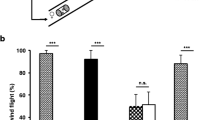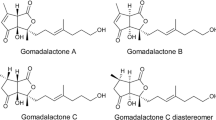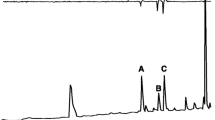Abstract
The first isolation and characterization of a sex pheromone from a zooplankter is reported. A 29 kdalton glycoprotein on the surface of females of the marine rotifer Brachionus plicatilis acts as a contact-mating pheromone. This glycoprotein (gp29) is glycosylated with oligosaccharides containing Nacetylglucosamine, mannose, and fucose residues, and these oligosaccharides are necessary for male recognition of females. Males detect this signal by contact chemoreception with receptors located in their corona. Binding of purified glycoprotein to male receptors reduces mating attempts by 93%. An antibody to the glycoprotein binds to females, reducing male mating attempts by 86%. When purified gp29 is bound to sepharose beads, it is sufficient to elicit male mating behavior. This glycoprotein is likely to play a key role in the evolution and maintenance of reproductive isolation in rotifers.
Similar content being viewed by others
References
Aloia RC, Moretti RL (1973) Mating behavior and the ultrastructure of copulation in the rotifer Asplanchna brightwelli. Trans Am microsc Soc 90:371–380
Atema J (1985) Chemoreception in the sea: adaptations of chemoreceptors and behavior to aquatic stimulus conditions. Symp Soc exp Biol 39:387–423
Borowsky B (1991) Patterns of reproduction in some amphipod crustaceans and insights into the nature of their stimuli. In: Bauer RT, Martin JW (eds) Crustacean sexual biology. Columbia University Press, New York, pp 33–49
Carde RT, Baker TC (1984) Sexual communication with pheromones. In: Bell WJ, Carde RT (eds) Chemical ecology of insects. Sunderland, Massachusetts, Sinauer Associates, pp 355–383
Carr WES, Ache BW, Gleeson RA (1987) Chemoreceptors of crustaceans: similarities to receptors for neuroactive substance in internal tissues. Envir Hlth Perspectives 71:31–46
Clement P, Wurdak EW, Amsellem J (1983) Behavior and ultrastructure of sensory organs in rotifers. Hydrobiologia 104: 89–130
Dunham PJ (1978) Sex pheromones in Crustacea. Biol Rev 53: 555–583
Dunham PJ (1988) Pheromones and behavior in Crustacea. In: Endocrinology of selected invertebrate types. New York, Alan R. Liss, pp 375–392
Gilbert JJ (1963) Contact chemoreception, mating behavior, and sexual isolation in the rotifer genus Brachionus. J exp Biol 40: 625–641
Gleeson RA (1991) Intrinsic factors mediating pheromone communication in the blue crab, Callinectes sapidus. In: Bauer RT, Martin JW (eds) Crustacean sexual biology, Columbia University Press, New York, pp 17–32
Huyton PM, Langley PA, Carlson DA, Schwartz M (1980) Specificity of contact sex pheromones in tsetse flies, Glossina spp. Physiol Ent 5:253–264
Katona SA (1973) Evidence for sex pheromones in planktonic copepods. Limnol Oceanogr 81:574–583
Knowlton N (1993) Sibling species in the sea. A Rev Ecol Syst 24: 189–216
Kubota T, Tokoroyama T, Tsukuda Y, Koiama H, Miyake A (1973) Isolation and structure determination of blepharismin, a conjugation initiating gamone in the ciliate Blepharisma. Science, NY 179:400–402
Laemmli UK (1970) Cleavage of structural proteins during the assembly of the head of bacteriophage T4. Nature, Lond 227: 680–685
Larsson P, Dodson S (1993) Chemical communication in planktonic animals. Arch Hydrobiol 129:129–155
Liener IE, Sharon N, Goldstein IJ (1986) The lectins. New York, Academic Press
Luporiri P, Micelli C (1986) Mating pheromones. In: Gall JG (ed) The molecular biology of ciliated Protozoa, New York, Academic Press, pp 263–299
Miyake A, Beyer J (1974) Blepharmone: a conjugation-inducing glycoprotein in the ciliate Blepharisma. Science, NY 185: 621–623
Osawa T, Tsuji T (1987) Fractionation and structural assessment of oligosaccharides and glycopeptides by use of immobilized lectins. A Rev Biochem 56:21–42
Palumbi SR (1992) Marine speciation on a small planet. Trends Ecol Evol 7:114–117
Rence B, Loher W (1977) Contact chemoreceptive sex recognition in the male cricket, Teleogryllus commodus. Physiol Ent 2:225–236
Rico-Martinez R, Snell TW (1995) Mating behavior and mate recognition pheromone blocking of male receptors in Brachionus plicatilis Muller (Rotifera). Hydrobiologia (in press)
Schlein, Y. Galun R, Ben-Eliahu MN (1981) Abstinons. Male-produced deterents of mating in flies. J chem Ecol 7:285–291
Segers H (1995) Nomenclatural consequences of some recent studies on Brachionus plicatilis (Rotifera, Brachionidae). Hydrobiologia (in press)
Sharon N, Lis H (1989a) Lectins as cell recognition molecules. Science, NY 246:227–234
Sharon N, Lis H (1989b) Lectins. New York, Chapman & Hall
Snell TW (1989) Systematics, reproductive isolation and species boundaries in monogonont rotifers. Hydrobiologia 186/187:299–310
Snell TW, Carmona MJ (1995) Surface glycoproteins in copepods: potential signals for mate recognition. Hydrobiologia (in press)
Snell TW, Childress MJ, Winkler BC (1988) Characteristics of the mate recognition factor in the rotifer Brachionus plicatilis. Comp Biochem Physiol 89A (3):481–485
Snell TW, Garman BL (1986) Encounter probabilities between male and female rotifers. J exp mar Biol Ecol 97:221–230
Snell TW, Hawkinson CA (1983) Behavioral reproductive isolation among populations of the rotifer Brachionus plicatilis. Evolution 37:1294–1305
Snell TW, Hoff FH (1987) Fertilization and male fertility in the rotifer Brachionus plicatilis. Hydrobiologia 147:329–334
Snell TW, Morris PD (1993) Sexual communication in copepods and rotifers. Hydrobiologia 255/256:109–116
Snell TW, Morris PD, Cecchine GA (1993) Localization of the mate recognition pheromone in Brachionus plicatilis. (O.F. Müller) (Rotifera) by fluorescent labeling with lectins. J exp mar Biol Ecol 165:225–235
Snell TW, Nacionales MA (1990) Sex pheromone communication in Brachionus plicatilis (Rotifera). Comp Biochem Physiol 97A: 211–216
Stanhope MJ, Connelly MM, Hartwick B (1992) Evolution of a crustacean chemical communication channel: behavioral and ecological genetic evidence for a habitat-modified, race-specific pheromone. J chem Ecol 18:1871–1887
Wallace RL, Snell TW (1991) Rotifera. In: Thorp JH, Covich AP (eds) Ecology and classification of North American freshwater invertebrates. New York, Academic Press, pp 187–248
Wiese L (1965) On sexual agglutination and mating type substances (gamones) in isogamous heterophallic Chlamydamondes. I. Evidence of the identity of the gamone with the surface components responsible for sexual flagellar content. J Phycol 1:46–54
Author information
Authors and Affiliations
Additional information
Communicated by N. H. Marcus, Tallahassee
Rights and permissions
About this article
Cite this article
Snell, T.W., Rico-Martinez, R., Kelly, L.N. et al. Identification of a sex pheromone from a rotifer. Marine Biology 123, 347–353 (1995). https://doi.org/10.1007/BF00353626
Received:
Accepted:
Issue Date:
DOI: https://doi.org/10.1007/BF00353626




